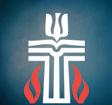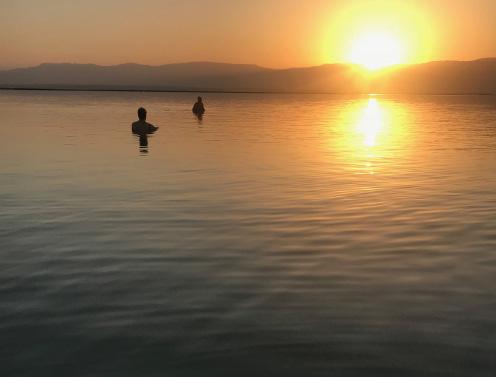PINNACLE
Jesus walked theRe & those who call this place home today, the “living stones.”

holy land reflections

to be a community, Rooted in c h R ist, R eaching out in love
to be a community, Rooted in c h R ist, R eaching out in love

Jesus walked theRe & those who call this place home today, the “living stones.”

holy land reflections

to be a community, Rooted in c h R ist, R eaching out in love
to be a community, Rooted in c h R ist, R eaching out in love
In this Spring Pinnacle edition we are blessed to read meaningful reflections from our fellow PCJH pilgrims who journeyed to the Holy Land in October 2022. Our hope is that you will get a glimpse of the different locations and people they met in the various parts of the Land. May you be encouraged and challenged by their experiences.
“I remain confident of this: I will see the goodness of the Lord in the land of the living.”
u Psalms 27:13
� please check pcjh.org calendaR FoR updates as all pcJh events subJect to change �
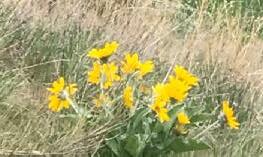
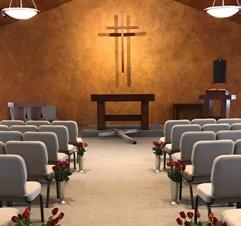


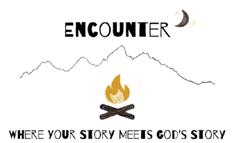
tH e H OLy Land I t I nerary CO vered visiting the historical locations of the Bible and providing diverse perspectives on the current situation in Israel and Palestine. When I reflected on what I’d be most excited to see and learn, I felt the Holy Spirit guide me to seek to study the people – those from the Hebrew Bible (aka the Old testament); those when Jesus walked there; and those who call this place home today, the “Living Stones.” to begin to understand, one must learn about the history of the land.
My journey of discovery began in the early afternoon of our second day when our group was welcomed by our Spirit-filled guide, andre Moubarak. We boarded our bus and traveled from tel aviv to the negev desert and a hotel on the shores of the dead Sea. as the sun began to set, we delighted in the experience of floating in the salty water. We woke up early to a beautiful sunrise over the mountains of Jordan to begin our pilgrimage. andre’s theme for the day was “the desert: a Place of Preparation.” I wondered, “What will the desert teach and how will it prepare us?”
Our first stop was Masada (Hebrew for “Fortress”), a hill 1400 feet above sea level, that bore the archeologic remains of Herod the Great’s fortress built in the 1st century. as the last stronghold of the Jewish zealots, it fell to the romans in the Great revolt (66-73ad). Over the centuries, occupants of Masada put their faith in this impressive stronghold and believed that they were secure there. yet, their security was temporary. today, as in ancient times, we are called to put our faith and trust in God who is our fortress. andre urged us to contemplate what besides God is a “fortress” in our lives?

nearby, we visited the desert home of Bedouin people, descendent from abraham, who provided us the experience
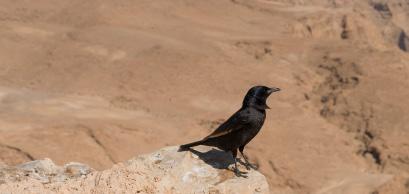
of riding on a camel and sharing a traditional meal. Upon the back of my surefooted camel, Sharon, I was able to take in my sparse surroundings while our Bedouin guide told us of the adaptations of camels, travel routes, and how the desert acacia tree’s wood was used to make the ancient tabernacle as well as shepherds’ staffs. Suddenly, I was surprised by small birds that flew in front of me, out of nowhere, and heard myself asking my neighbors, “did you see that?” but they were caught up in conversation. a flood of emotion overtook me as I thought of how God takes care of the sparrows in the desert and how much more he’ll care for me. What was the desert teaching me?
andre taught us that the desert has been and is a place of transformation. the desert gives us lessons for maturity, and in the silence of the desert one can hear that simplicity is key, as is reliance on God and community. We are not meant to function alone. after the desert follows an appreciation of the freedom that comes from trusting in God. as we receive this revelation, we are called by God to share this with others. even in the desert and darkest parts of life, there is joy because God is with us.
Up next… an oasis in the desert? yes. david sinned, repented, and fled into the desert from King Saul. david trusted God and was led to a safe place, ein Gedi, a desert oasis with freshwater, beautiful vegetation, and wildlife. It was a refuge where david hid from Saul in the caves and wrote many of the Psalms. With a view of Masada, he wrote Psalm 18:2 “the Lord is my rock, my fortress, and my deliverer.” Hiking through ein Gedi, the past came alive, and it was clear how this place gave the Israelites of the past and us a glimpse into how God provides in the midst of suffering. When we mature in our faith and personal relationship with God, like david, we can see that suffering also shows us our blessings.
In learning about the desert and its relationship with God’s people of the past and present, I learned more about myself and my relationship with God. “even the sparrow knows, he holds tomorrow.*” I pray that I, and my fellow pilgrims, will always remember what we experienced together and individually in the Holy Land, and that we keep seeking for what else it has prepared us. ✝
iS tarted t H e tr IP a S a blank piece of paper. no expectations. the only plan was to have a great time. I have read the biblical stories, but nothing like seeing it in person could ever do it justice. you just have to go!! Originally I wanted to write about the dead Sea areas, but that involves a story that I hope one day turns out great. time will tell, and those who know me understand that I have given it to God (very reluctantly).
Just to let everyone know the hotels, bus, food throughout the trip were fantastic. andre, our tour guide, is much more than that, he is a special person. not only did he grow up in Jerusalem, he takes no sides, knows the history so well, and is a great man. andre is the storyteller of Israel, I felt like was experiencing life in Israel today, yesterday, and 2,000+ years ago. From culture to food from scripture to modern day life from conflict to passion Israel has it all and andre took us on a journey through it all. this left an impact on us all and brought us together.
Our hotel in Galilee was located on the water in tiberius. Bill and I were roommates for the trip. I could not have asked for a better person. I barely knew Bill before we arrived at the Holy Land. after we arrived from the Jordan river and settled into our room, I went down to the lobby to meet with others to talk about what we had experienced that day. there were four others who joined me as we sat outside and watched the sunset turn to darkness over the Sea of Galilee. When I started the trip, I barely knew any of my fellow travelers. during those two hours, I learned more about my traveling companions. We are all different, and all travelers; just like the people 2,000 years ago when Jesus was making his journey. after dinner we returned to the same spot, with more people joining us from dinner. this was the start of a fellowship which grew throughout the trip. each and every night before dinner, although not mandatory, everyone gathered to share the events of the day, or their thoughts and experiences. Some of our discussions were history lessons or just clarifications as to why things are the way things are. this was truly God showing us what fellow-
ship truly is. each night after our first night in Galilee our group just got bigger and bigger, until it was everyone on the trip. It is said if you really want to know someone walk a mile in their shoes. I can say that in Israel we all walked in Jesus’s shoes and that He also walked with us.

On the third day in Galilee, we had a boat trip that was to simulate how the fishermen during the time of Jesus worked (Peter and andrew). at first it was a little hokey, but when we cast out a net to catch fish, something amazing happened -- we caught a fish! the tour guides were amazed because nobody had ever caught a fish before. I found this symbolic of the whole trip because Jesus told Peter to change his occupation from being a fisherman to being a fisher of man. this group of 29 people from very diverse backgrounds and beliefs came together loving each other and accepting God’s love for everyone. We are His family.
In looking back, three months later, the relationships that started in Galilee have grown and are still growing into some of my strongest friendships. those who think that Jesus is gone are wrong; He was there with us the entire trip and continues to be with us each and every day. I went to Israel as a blank sheet of paper and came back with great friends, great memories, and a full heart. ✝
bRad heRman "Why you Brad? Why you Brad? Because: God." Says Brad. Brad also portrayed as the angel Gabriel in PcJh christmas pageant.

iH ave a LWay S Wanted t O v ISI t t H e H OLy Land even as a child. I’ve been deeply curious to smell the air, to touch the stones, to walk the shores and land of a place that had been set in my mind as I listened, learned, and read stories from the Bible. My husband, trent, gifted me with a trip to Israel with PCJH for my 50th birthday. I was excited to see the place, but I had no idea how transformative it would be for me to meet the people and experience the culture as we journeyed.
While in Israel we spent every day with our tour guide, andre, who constantly challenged us to see things not from our Western world mindset but through Middle eastern eyes. not to come offering solutions but to listen with open hearts and minds. not to take sides but to be peacemakers. We worshiped in a Palestinian arab Christian Church, met with a Palestinian Christian family who runs a farm project called tent of nations, and we met with Palestinian muslims at the aida refugee Camp. We also met with a rabbi, toured the yad vashem—the World Holocaust remembrance Center, and met with two members from Parents Circle.
the most impactful interaction I experienced while in Israel was in meeting with two members from Parrents Circle—an Israeli-Palestinian organization made up of more than 600 bereaved families. the only way one can become a member of Parents Circle is if they’ve lost a family member due to the conflict. Parents Circle is a grassroots organization that desires to bring about reconciliation between Israelis and Palestinians thru dialogue and the sharing of their bereavement stories. First we heard from an Israeli man who vividly told us of how he came to

find out that a Palestinian suicide bomber had killed his daughter, who was fulfilling her mandatory service to the Israeli army. Several years later he was invited to come to Parrents Circle to hear stories similar to his own; he found common ground with his enemies and learned that pain and suffering are universal no matter which side of the conflict one finds themselves to be. He chose to stop drawing from a well of hatred, revenge, and violence and instead found transformation in forgiveness, hope, and healing. next we heard from a Palestinian Muslim woman who had lost her 6 month old baby boy. She shared how her baby was asleep in his crib at night and overwhelmed when the Israeli army deployed tear gas in her village. She rushed out into the night to seek medical attention for her child. the military zone prevented her from gaining access to the nearest hospital. the main road to nearby Hebron was closed. the only choice she had was to leave via the Israeli checkpoint; sadly, she endured a 4 hour stop. When she finally gained clearance, they raced to the hospital. the baby was admitted into ICU. the mother was told that she could not stay with her child and that she would be called with an update. Several hours later, she was told by phone that her son had passed away and that she could come and retrieve him. I will never forget her telling us what it was like to feel his lifeless body in her arms. as a mother, I have found her story etched upon my heart. She shared how she never sought revenge but said she found herself full of anger and hatred. Many years later she too found Parrents Circle and through the sharing of her story, she has found healing, forgiveness and reconciliation. In the closing of our time together, the Israeli man and the Palestinian woman implored us not to take sides but to strive to be peacemakers.
I am so thankful for my time in Israel and for the stories of these precious living stones. I pray for this land and its people. Lord, help me to be a peacemaker. I pray for everlasting peace…peace that only Jesus the Prince of Peace can give. ✝

lIKe MOSt OF OUr GrOUP, I Had never been to the Holy Land before, but being reasonably versed in scriptures and an avid consumer of current events, I assumed I would be well prepared for what lay ahead. also, as an experienced world traveler, mostly for business-related trips around the globe, I was concerned about the length of this trip – two weeks. How would I endure such a long trip? due to the richness and variety of the agenda, the trip turned out to be the fastest 14 days in memory. My 32-year-old son, Chris, accompanied me on this exciting journey.
My story opens in the biblically and historically rich area of Galilee, which lies on the important and ancient trade route known as via Maris, Latin for “way of the sea,” and the Jesus trail. the fish harvested in this area were sold using this ancient and well-traveled trade route, and having a fleet of boats could produce considerable wealth in the first century.
Our pilgrimage was off-the-charts wonderful because of our tour guide and leader, andre Moubarak, co-owner of twins tours. andre grew up in the Old City of Jerusalem on the 7th Station of the via dolorosa—speaks his native aramaic language, plus Hebrew, arabic, French, english and more. andre is a scholar of biblical history (Old testament and new), archaeology, local geology, and the complex, and troubling relationship with Israeli and Palestinian officials and their respective populations.
Back to the trip ... when you first see the Sea of Galilee you notice how strikingly beautiful it is. the other noticeable thing is the size: 13 miles long by 8 miles wide, it is actually a lake, the lowest freshwater lake on earth – approximately 700 ft below sea level.

On the two-hour boat ride on the Sea of Galilee as our group took in the panoramic view, andre opened his arms and said “inside my outstretched arms is the general area where Jesus traveled for about 70% of his 3-year public ministry.” this area that andre was

referencing coincides with the Jesus trail, a pilgrimage route through Galilee from nazareth to Mount tabor.
d uring the boat ride, our crew demonstrated the method used for fishing in the first century which involved casting a net outward from the rear of the boat. the demonstration resulted in a fish caught and brought to the deck. Our group (many of them avid Wyoming fishermen) were suitably impressed, especially since this was a rare occurrence to actually bring a catch into the boat, we were informed. It was great to see a demonstration of how many of the disciples earned their living before they were recruited by Jesus to become “Fishers of Men.”
that evening a group of PCJH Pilgrims renewed their vows of baptism in the Sea of Galilee. My son, Chris, surprised me by joining this group and this became one of the highlights for me of the entire trip. What an amazing experience to look across the water at Chris and the others as they were immersed in this sacred place!
another fascinating stop in Galilee was Capernaum, the home of Peter. according to the Gospels, Capernaum became the home base for Jesus' ministry. We could imagine that Jesus and his followers would have been on the very ground that we could see from the first-century digs.
Other highlights of the trip—the first-century town of Magdala, visited by Jesus and the home of Mary Magdalen (discovered and archaeological digs done recently), and the ancient Galilee Boat, a first-century fishing boat discovered during a drought on the northwest shore of the Sea of Galilee. With some 35,000 active archaeological digs in Israel, there is no end to the thrilling and faith-affirming discoveries to be made on pilgrimage to the Holy Land. ✝
maRk l stRuhs was raised in texas, lived 20 years in chicago, traveled the world, but one foot and his heart has always been in Wyoming.
october 2022—a group of 26 “pilgrims” from Presbyterian church of Jackson hole embarked on a 14-day journey from the dead Sea to Jerusalem. PhotoS:













































“ how good and pleasant it is when God’s people live running down on the beard, running down on aaron’s
together in unity! it is like precious oil poured on the head, beard, down on the collar of his robe." u Psalms 133:1-2
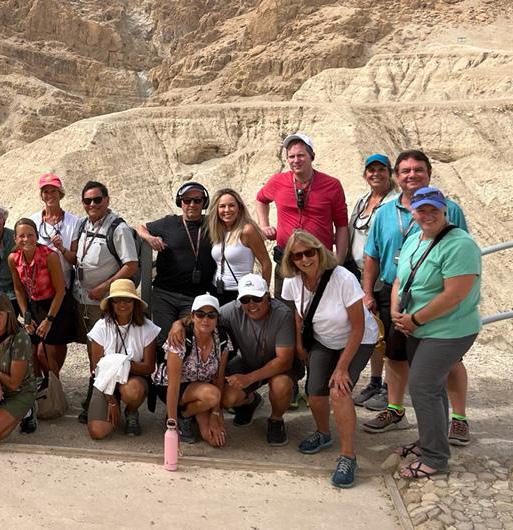

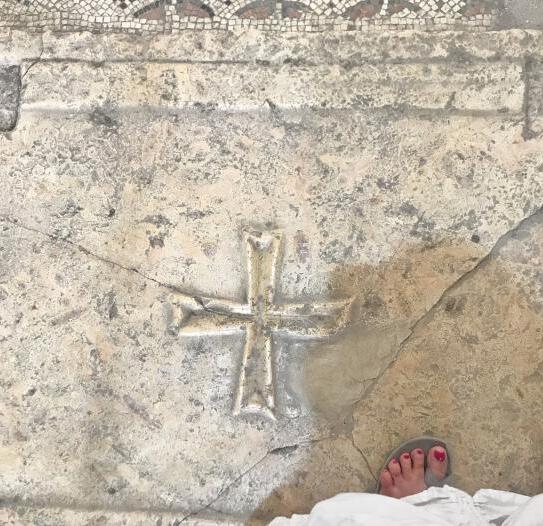

“
"... to think that Jesus, the prince of peace, was born in thousands of years ago, and there’s still oppression
MeGan: I’m so excited to reminisce about our trip together! Wow, It’s March…how many months ago was that? november, december, January, February… no way, it feels like such a long time ago since our pilgrimage!
aLLy: It feels like a year ago! Oh my gosh, just four months?
MeGan: I’m glad we’re taking this time to process the trip now that a few months have gone by. I feel like I know your answer a little bit already, but coming back, a frequently asked question was...
“What was the most impactful part of the trip for you?” So, how would you answer that now?
aLLy: the couple of days that we were in Bethlehem, in Palestine, were really impactful for me, and others on the trip as well. We visited holy sites from Jesus’ birth, like the Church of the nativity and the shepherd’s fields. We joined a beautiful worship service with Palestinian Christians at evangelical Lutheran Christmas Church, and learned from rev. dr. Mitri raheb about Bethlehem Bible College and the work the students and faculty are doing there to uplift their communities. Later that day, we visited aida refugee Camp, established in 1950. that was a powerful experience. It was an honor to be there, but also really heavy to see the conditions that these families have been living with for decades. their homes and land had been taken from them by force when the nation of Israel was established, people were killed. Communities were forced to relocate to aida Camp and the Israeli government in power still doesn’t have a plan for the residents. Our group met with a representative from aida youth Center, a nonprofit within the camp that aims to empower children & youth through creative outlets and community service. Hearing him describe the oppression they live under, the lack of resources and freedom, the hopelessness the nonprofit’s working to combat but that still spreads through the youth who live there, it was a lot to take in. Like, it’s sobering to think that Jesus, the Prince of Peace, was born in Bethlehem under the oppression of the roman empire thousands of years ago, and there’s still oppression and unjust treatment and prejudice there, still a group of people living under the power of another in this holy place. Of course, we know that Hope is present and active there as well, and it was uplifting to
witness God at work through the people and organizations we encountered.
Our guide showed us around aida Camp, we walked through the streets, said hi to the kids we passed playing outside. We went up to the roof of the organization’s building and looked out across the camp, at the wall. One of the roof’s glass doors was shattered, with a bullet hole through the center - our guide explained that gunshots, rubber bullets, tear gas are launched into the camp frequently by Israeli soldiers, to intimidate the Palestinian residents. While we were up there, there was a hissing sound, and we saw tear gas being thrown into the camp from the wall. One canister, two canisters. We were quickly ushered downstairs, through the streets and to the bus. you could smell the chemicals in the air. as we were driving back to our hotel, we passed a street already blocked off with what looked like the beginning of a riot - a car and tires on fire, people running. It was a firsthand glimpse of the conflict. the violence that people there live with, it’s just…. no child should grow up in that. no one should have to live with that reality. How about you? What stands out to you when you think back to the trip?
MeGan: Well, having been roommates in the Holy Land, I know we were both impacted by our time in Bethlehem specifically. Hearing you recount our experience at the �

refugee camp, I’m reminded of how overwhelmed I felt witnessing such a different reality. the next day we visited the tent of nations. Spending the afternoon there has remained one of the most memorable and meaningful memories for me.
It was surprising to walk around the farm (daher’s vineyard) and see people from around the world who had come to help with harvesting and caring for the land. Meeting daoud nassar, and hearing his and his family’s story of persecution caused me a lot of self reflection. as Palestinians they face prejudices and hostility from the Israeli settlements around them. the nassar family established the farm in the early 1900’s and have since been forced to defend ownership of their land from Israeli government officials.
as Palestinian Christians, for 30+ years they have chosen active non-violence as a way of fighting to be recognized as legal owners of the farm. they choose this, daoud explained, because they see it as a reflection of how Jesus acted in situations of injustice.
their long-standing legal battle and daily choice to seek justice with such peace resulted in my questioning of the ways in which I am impatient when it comes to situations in my life that require perseverance. this is crazy… the nassars at tent of nations have been waiting longer than I've been born for justice to unfold! I remember thinking, “How often do I wait for certain things and then get frustrated when the results don't come quick enough?” (the answer was very often).
So, I think that whole day was meaningful for me because my personal reflection was invited by daoud’s story and his peaceful and grace-filled presence. He was so innately aware of Jesus as an advocate for social justice and for equity. He knew, and knows, that the Lord is HIS advocate; that was a really powerful, fresh revelation.
aLLy: Wow, yes. Like you were saying, to hear the family’s story and realize, after the physical attacks they’ve survived, after the destruction of their property, after years of slogging through a discouraging and hostile court system, they’re still choosing love. they still feel and believe in the love of Christ, not only for themselves, but for everyone around them. no matter ethnicity or religion, their motto is “we refuse to be enemies.” and they live out that love despite every external circumstance. It's so humbling. Such a beautiful witness to who God is.
Is there anything else that struck you from our time at Tent of Nations?
MeGan: another thing that stood out to me that tent of nations has in common with the other ministries we visited in Bethlehem was the emphasis on art as a powerful tool to heal,

process, and share one’s story. art is something that I've always used as a hobby or leisurely activity. It was beautiful and emotional to see and hear about Palestinians, especially youth, creating art expressions as a way to process through trauma and painful experiences, but also as a way to reclaim their humanity.
aLLy: yeah, I agree. really powerful that an emphasis on art is a fight against dehumanization, a way to say “I’m here, I’m beloved, I’m worthy” and claim something more than victimization. Both groups, Israelis and Palestinians, have experienced so much suffering and have very real generational and personal trauma. But true reconciliation and healing won’t happen until people recognize their own inherent humanity and dignity and recognize the humanity and dignity of the “other.”
MeGan: yes! that also totally relates to the Parents Circle, which one of our fellow pilgrims expands on in another article. Our time with those Palestinian and Israeli parents was an important example of what that reconciliation and healing can look like.
aLLy: yes. the tent of nations into the Parents Circle was such a good conclusion to our time exploring the conflict, hearing different voices, and getting a glimpse of a more hopeful future for all - what could be.
MeGan: ah, so true. What a good reflection. there were many hard and complicated observations and interactions that we observed and participated in, but there were also glimpses of hope. that reminds me of Jeremiah 29:11. Hope, in the Lord, for flourishing relationships and a future of prosper, not harm.
May we all participate in the hard work of listening and bearing witness to others’ stories and labors for peace and reconciliation. ✝

iB e C a M e a M e MB er OF PCJH L a S t summer after having been a member of University Presbyterian Church in Seattle for nearly 40 years. My wife Maribeth and I were blessed to be able to join the trip to the Holy Land last fall. My personal and professional travels have taken me all over the world, but never to the Middle east, so this trip was a new and exciting experience for both of us.
Having read and heard Bible stories throughout my life, I assumed I would have a sense of the place and its geography. I was so wrong. despite being the birthplace of humanity and history, the Holy Land is a remarkably small place, quite unlike the expansive areas we enjoy here in the West. It is also a place riddled with conflict… more so, perhaps than any other place on earth.
the ‘smallness’ and conflict are particularly evident in Jerusalem. the events of Christ’s passion all occurred within a space about a third the size of the town of Jackson and we easily walked the short distances between the various sites of historic importance, through the ever-present signs of conflict.

the Old City of Jerusalem is divided into four quarters: Jewish, Muslim, Christian and armenian. Jews and Muslims have been fighting over it for centuries, and over that time, they have each controlled it at one point or another. Currently, the Jews are in control and that fact is made clear to all. during our walk through the via delarosa we witnessed armed brigades of young IdF soldiers on patrol and heard accounts of armed conflict between Muslims and Jews at checkpoints we had passed through. despite Jewish control, the Muslim quarter is the largest, centered on the dome of the rock, a glistening gold structure with an iconic view of the Jerusalem skyline. It’s the oldest existing Muslim monument in the world, and sits adjacent the al-aqsa Mosque, which is considered by Muslims to be the place where the Prophet
Mohammed had his encounter with God.
Jerusalem is a place where people encounter God. I did as well… but without any urge to fight about it. andre, our tour guide said, “People here just need to grow up”. either that, or better know the God of the Bible, who lived, loved and died for us on the same ground they continue fighting over.
Prior to Jerusalem, we visited Bethlehem, where we learned shepherds there would raise and tend their flocks and take the ‘spotless’ lambs to Jerusalem to sell for sacrifice at the temple, a practice that continued to the end of the last century. that sounded familiar to me.
then in Jerusalem, we walked the steps of Jesus, emmanuel, the Lamb of God, who was and is with us, in humanity, humility and passion. Places those steps took us included the Garden of Gethsemane, the via delorosa and the Garden tomb. But the place that was most moving for me was the Church of the Holy Sepulchre, built in 336 ad over one of the places Jesus was thought to have been crucified and buried and includes a shrine thought to enclose the His tomb.
there was a line of people from around the world waiting to enter, kneel and pray before His tomb and sing songs in praise. We did those sacred things as well. But the part of that experience which was most moving for me was listening to the songs. One of the unique and fitting attributes of the church is its incredible reverberation where words and music reverberate throughout the sanctuary for six seconds or more. I think it’s fitting because the tomb wasn’t the end. His story continues to reverberate throughout history. the story is true. God was here. Believe it. ✝
wH at M ade t HIS H OL y Land tr IP so memorable was andre Moubarek, our trip leader, whose brilliant concept in creating this unique tour was to capture the many facets of ancient and modern Israel. naturally, our primary attraction was to experience the actual historical locations of Jesus' life from birth to resurrection. But with andre's brilliant teachings, he opened our eyes to eastern thinking and First Century biblical interpretations. additionally, with his encyclopedic knowledge of the archaeological and historical locations, he provided us unique perspectives from ancient, pre-Jesus times to modern day conflicts. this truly life-changing trip provided quite a new insight into the bible and its lessons because we saw it in person. and as a group, all agreed we were excited to again read the bible with all that we learned and experienced.

as our Holy Land pilgrims landed in the modern, hip city of tel aviv, our transition had begun. the expectations we felt sent shivers down our spines. a number of our intrepid travelers arrived early to manage jet lag and to begin our journey by seeing the modern Israeli culture in tel aviv.
On our first evening dinner had us headed to the beach area to sample the local cuisine and work out the kinks from that long flight. It became evident how each member of the group was very interested to learn more about each other. this interest continued throughout the trip that evolved into close friendships that continue today.
the next day, we headed to the beautiful, white sand beaches along the Mediterranean Sea for the walk to the city of Jaffa, one of the oldest seaports in the world. naturally there were many beach fishermen seeking the edible treasures from the red Sea. as we neared Jaffa, there was a stark juxtaposition in such a short distance between mod-
ern tel aviv and this ancient city. through the narrow alleys and steps, we found various historical evidence that began our education of ancient biblical times. We experienced the first stunning biblical recognition seeing Simon the tanner's house, where the Bible speaks of Peter’s staying at this location. Unique stone artwork and interesting signage illustrated various stories in the Bible. We wandered through the fish markets realizing these same areas go back thousands of years. and while heading back to our hotel, we heard that sound of that distinctive singing calling Muslims to prayer. Close to that mosque was a Jewish temple and other eastern religious temples. relating to the US, we have our various Christian churches, Jewish temples, russian Orthodox etc. Here we were to see very distinctly different religious beliefs that shaped the Mideast over thousands of years.
Later we visited the historically spectacular ancient city of Caesarea. Having been built by Herod the Great about 25-13 BCe, this visually stunning historical city served as a major seaport. We all were blown away at the size and scope of this city that abuts the deep blue, crystal clear waters of the Mediterranean Sea (shown above). With its amphitheater overlooking the sea that seated thousands, its hippodrome that held chariot races, complete with the first known toilets, to its Palace that touched the Sea, we were in continued awe as we contemplated the vision. It was sad to see that in the 7th Century, the last city of the Holy Land fell to the arabs. the city then degraded but reconstruction efforts allowed us this view the shell of its greatness in the past.
these two cities were just a few of the many stops we experienced during this once in a lifetime trip. I started with the idea of transition and it was completed when we returned to tel aviv to fly home. Our transitions included understanding modern conflicts along with new perspectives of eastern, First Century thinking by experiencing first-hand, magical locations where Jesus spent his life and how it inspired our seeking new perspectives in understanding stories in the Bible. ✝

wH at C an B e S a I d a BOU t t H e H OL y City? articulating the dynamic life this place holds is such a feat. Jerusalem was the perfect ending to our pilgrimage. Before even embarking on the trip, I did not know what to expect. I have been a world traveler since I was 14 years of age. I was blessed with parents who valued my exposure to a range of epistemologies and worldviews which only helped me develop an open mind to peoples all over the diaspora. the Middle east, however, held something more profound.
the Holy City was truly that: Holy. there was a deep-rooted sense of belonging. It held mystery, pain, knowledge, fear, excitement, and wonder. you were not just walking on stones that supported the current cars, trains, bikes, etc… these paths supported the footsteps of yeshua. and here they remain… supporting my own. It makes me weak in the knees and my throat tightens with the thought.
I was raised to understand the nature of who Jesus was, not a lot of my spiritual development was focused on, or around the Old testament, at all. What this trip changed in my own life and spirit was the ‘coming to life’ of the Old testament. I stood in david’s kingdom. I mean, WHat?! I was standing where the history of Christianity started.

Like I stated previously, I’ve been traveling the world since I was an adolescent. But nothing has changed my heart more than traveling to Jerusalem. Our new friend, andre, prepped our hearts and minds to be present for the dynamic lifestyle we would encounter in Jerusalem. But more than that, he brought the perspective and insight that every human, not just Christian or modern disciple, deserves to know about the life and history of Jerusalem. From standing in the olive trees of the Garden of Gethsemane, to the Garden tomb, every step was wholly observed and attended to with care and a dedicated explanation. If you haven’t read andre’s book about the via dolorosa, you must. I cannot stress that point enough.
But as andre continued to reiterate, we didn’t just come to visit the Holy City to observe and learn from the ‘old stones’, but to encounter and understand the ‘living stones.’ to understand their voices of pain and frustration, as well as join them in the celebrations they find
each day. the Western Wall was a symbol of an experience of the ‘living stones.’ after visiting with a rabbi a few days earlier and hearing his anger surrounding the fact that he could not worship where he desired, I witnessed the dedication Jews have to creating a space that still serves as a safe space where worship can happen. young children and the elderly opened their hearts in this space. I was moved by their devotion and was overwhelmed with its significance. Who knew a wall could bring so much to so many?

But that was the WHOLe trIP! Old stones brought life and spirit to the living stones. each archeological discovery created more understanding and more connection to the history of the lives before the arrival of Jesus and after.
What hurts my heart is how knowledge is manipulated in the city. Knowledge is sought out like currency and then corrupted and twisted. yes, Jerusalem was powerful and holy, but the pain and the corruption is very real. Knowledge of who built what, when, and where? It was used as power to exclude or given as a reason to discriminate and evict. I wonder if Jesus would weep for his beloved city? Human history started in this space, and even till this day the burdens of being a human, born into sin, remain true. Corruption, hate, discontent and discord reach all ends of the earth. Suffering is not just a problem for one group of people. andre made sure we understood this point by paying attention to the deep anger that runs through the different groups inside the Old City and beyond. He asked us to pray. “Pray for Jerusalem. Pray for us.” Peace will not come through proving who is right or wrong, or who is deserving of what, or who has suffered more. the lesson of Jerusalem comes from the One who brings grace, sacrifice, and forgiveness. the lesson of what all of humanity is in desperate need is acutely felt in this Holy place. thank you andre for your teachings, thank you Lord for your presence and unending love. We love and will continue to pray for you, Jerusalem. ✝
Bultema
Pastoral
Rev.
x 101
Rev. Tammy Mitchell tmitchell@pcjh.org
x 104
Office Staff
Brian Bultema bbultema@pcjh.org
x109
Cindy Dahlin cdahlin@pcjh.org
x107
Ally
Program
Laura
x102
x123
Amanda Lack alack@pcjh.org
little lambs Director x111
Preston Gordon pgordon@pcjh.org
Interim Children’s Ministry Coordinator x103
Megan Walker mwalker@pcjh.org
youth & young adult Ministry Coordinator x124

Ruling Elders
Class of 2023
Caryn Haman adult Ministry
Josh Ziolkowski young adult Ministry
Alan Lund Personnel
Patty McDonald assimilation & Nomination
Clerk of session: Ken Blount
2024 Caryn Haman adult Ministry
Josh Ziolkowski young adult Ministry
Alan Lund Personnel
Patty McDonald assimilation & Nomination
2025
Sarah Romorini Mission
Trent Doyle Children’s Ministry
Tiffany Tate Congregational life
John Scott Finance
teaching elders: rev. Ben Pascal & rev. tamara Mitchell
Deacons
Class of 2023
Michael Schrotz*
Ponteir Sackery
Brian Bultima
Sandra Guido
Fernandez
Class of 2024
Lori Dodd*
Brad Herman*
Joy Steiner*
Tom Segerstrom
Class of 2025
Cameron Page
Dorothy Neckels*
Catherine Wade*
Sierra Fulton*

My husband Matt and I moved to Jackson a few years ago, most recently from Washington d.C. I love being outside and exploring. I was drawn to PCJH’s kindness, great sermons (kudos, Ben and tammy!), and an amazing ability to connect with communities near and far. I might have gotten on PCJH missions radar as I work in international development, and was previously based in el Salvador, argentina, and Malawi.

While I haven’t been to the Holy Land, I would be humbled to visit Bethlehem. I like imagining the simplicity, taking away all the pomp and distraction and remembering what Christmas is really about!
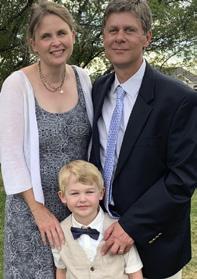
Greetings. My name is trent doyle. I was born and raised in northeastern Ohio and moved to Colorado shortly after graduating high school. after attending college in Colorado and working as an engineer for several years in the denver area, I headed back east for more schooling and a couple career changes.
Our family (traci and Josiah) moved to Jackson a little over two years ago after having spent 24 years in virginia. I love hiking and exploring the outdoors and I am excited to be back out west. Growing up, Sunday school, backyard bible clubs, summer camp and youth mission trips all played formative roles in growing my faith in Christ. Being part of an intergenerational church as a child and young adult was a special privilege and I was excited to find that here at PCJH.
Our family began attending PCJH virtually during the pandemic and we have enjoyed the opportunity to begin to get to know the community on a more personal level over the past year. I look forward to becoming more engaged in the days ahead as the new Children’s Ministry elder. I have never been to the Holy Land but if I had the chance to visit, I think I would enjoy walking along the Sea of Galilee and envisioning what it might have been like to meet Christ there.
I’m a new Wyoming resident as of this past year. Previously I resided in new Jersey with the exception of attending Miami University of Ohio (undergraduate) and Marywood College in Pennsylvania (graduate school). afterwards, I spent time working as a registered dietitian.
the decision to join PCJH was inevitable. My maternal family came from a long line of Protestant parishioners in Scotland from the ‘Bell’ family lineage. One of my distant relatives was a Protestant minister who penned one of the hymns in our present-day hymnal.
Upon immigration through ellis Island in the 1920s, my maternal grandmother worked as a nanny in Manhattan. Here, she became very friendly with another Scottish nanny who, in essence, became family known affectionately as my ‘aunt Flo.’ the reason I digress is my aunt Flo worked for the minister of ‘the Little Church around the Corner’ in new york City.
Having been exposed to various family members and having been brought up Protestant my entire life, it was natural that I would also raise my children in the Presbyterian Church. they were baptized and brought up in the Presbyterian Church of Upper Montclair in new Jersey. Several years later my husband Peter and I decided to join two of my children out West, whereby we found and joined PCJH.
I have not been to the Holy Land yet, but the place that holds the most interest for me would be Jerusalem. I would like to see the upper floor of King david’s tomb which is the room of the Last Supper. It holds significance to me as I had seen Leonardo davinci’s ‘Last Supper’ painting in Milan, Italy a few years ago.
